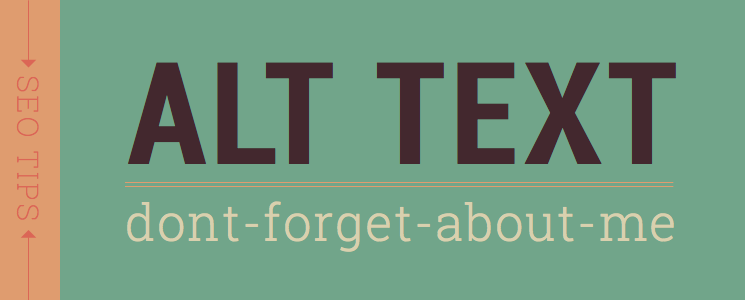Don’t Forget Your Alt Text: SEO for Images

When it comes to SEO, most people tend to think of keywords and links, but that’s just the tip of the iceberg. You can also optimize images to help increase your site’s visibility for image-related searches. Taking the time to optimize the images on your website can not only boost your organic traffic, but it can also help ensure that you’re providing the best possible user experience.
Here are just a few simple ways to ensure that your images are optimized for search engines:
Alt Text
Alt text is perhaps the single most important element in optimizing images for search. The original purpose behind alt text (also known as the alt attribute) was to help seeing impaired people or users with images disabled in their browsers. Essentially, this text provides a description of the image. Think of it as a kind of closed captioning for the web. It’s crucial for SEO because this bit of text is the only way search engine bots can interpret the content of an image. Remember, they don’t see pictures like we do; they only read words.
Guidelines on this text are a little amorphous, but I generally try to keep it at seven words maximum. When I write alt text, I imagine that I’m describing the image to a blind person. That way, I’m sure that I’m using the attribute as it was intended and that the text I’m crafting sounds natural. Unfortunately, like many things in SEO, alt text has been abused through keyword stuffing. You can (and should) use keywords in your image alt text, but only where appropriate and relevant. If it comes down to including a keyword or being descriptive, I always, always forego the keyword. As another general rule of thumb, try to avoid duplicating alt text, as this will dilute any potential SEO benefit.
More often than not, I see blank alt attributes when working on websites, but taking the time to add this small bit of text in your code will make your images much friendlier for search engines.
Filename
Be sure to give all of your images descriptive filenames before you add them to your website. You can do much better than the jumble of letters and numbers you sometimes see with image files. If you’re dealing with multiple related images and still need to include numbers, that’s fine. I recommend doing something like this: red_car_01.jpg, red_car_02.jpg, etc. Having descriptive filenames can help boost the relevancy signals of your page for the keywords you’re targeting. Again, the same rules that apply to alt text apply here. Include keywords if applicable, but don’t stuff or force them into your filenames.
File Size
When adding images to your website, it’s important to make sure that the file size is optimized to reduce load time. Search engines (and users) don’t like sites that are slow to load, and if there’s one thing that can make a website sluggish, it’s lots of huge image files. If your site doesn’t load quickly, visitors will land there and bounce away, a phenomenon known in the SEO world as “pogo-sticking.” Essentially, a visitor comes to your website, leaves quickly, returns to the search engine results page and clicks on another result to find what they’re looking for. In addition to taking load speed into consideration, search engines also pay attention to the amount of pogo-sticking that happens. If you have a high percentage of users leaving your site quickly, the search engines are more likely to view it as irrelevant and rank it lower. The ideal file size for images will vary depending upon the project, but a good rule of thumb is 72ppi for normal, non-retina devices. Your art director or graphic designer should be able to help you make sure that all of your image files are sized appropriately.
Text Surrounding the Images
Where an image is located is also important for SEO. They should always be placed on relevant pages. You wouldn’t want to, say, post a picture of a sheep on a page with content about lions. Search engines read all of the text on a given page and piece it together to get the big picture of what the page is all about, so it’s especially important that everything works together. Again, this is a way to boost relevancy signals and improve the authority of your site in the search engines’ eyes. In addition, the closer the text is to the image, the more important it is from a search engine/ranking perspective. So, if you’ve got captions, put some thought into crafting short, informative copy that can help your image appear for related keyword searches.
A Simple System
Image optimization does get more complex than this, but you’d be surprised at what you can achieve by just implementing these basics. It can get a little overwhelming depending upon the scope of the site and the number of images, but if you’ve got the time and resources, it can be worth the effort. Chances are, once you’ve optimized images the first time, you’ll develop a system that will make it go even faster the next time!
